While customers almost expect to wait in line for their morning coffee or to pick up lunch, a business that has a line out the door can often result in lost customers. Likewise, an empty business could be as much of a turn-off as a draw – as some clientele think there is a problem, or that the shop isn't even open.
In the quick lube world, customers also expect to see busy technicians attending to vehicles, yet there needs to be a balance between having enough workers to service cars quickly yet without too many hands to make the work more awkward with employees getting in each other's way. It is a demanding task to staff each shift with enough employees to run the shop efficiently without having extra workers sitting around without tasks.
Some shops believe the best way to keep up with customer demand is to over-staff so that there are employees available to greet customers as they come in, as well as to handle overflow when the shop gets especially busy. While having a full house works for many shops, other location managers tend to staff a lean crew that can handle customers as they come in yet always stay busy and not get in the way of the work to be done.
Running at Optimal Staff
The total number of employees necessary to run a shop can be difficult to determine, which is why there needs to be set shifts for each day. Most shops will have two or even three shifts, depending on the hours of service. Shifts can work to a shop's advantage, where there is overlap during busy hours such as lunchtime, with fewer employees to finish out the day if more cars typically come in each morning rather than late-day service.
The full size of the staff has to take into account how many workers are needed for each shift, and how workers can be scheduled to work most efficiently together.
Lube and Latte in Lakeland, Colorado, an 1,800-square-foot shop with three bays—and a café serving espresso and other blends—has a staff of just five, which owner Duston Olde has found to be the best size to handle the business that comes in without overstaffing the shop.
"At Lube and Latte and Automotive Evolution in Golden, Colorado, it is one technician per bay," says Olde, who operates shops in Lakewood, Golden and Denver, with a new location set to open in Littleton.
"At Automotive Evolution in Denver it is approximately one tech per two bays," Olde tells NOLN.
Other shops may see the need to have at least five people working each day. Brian Morrison owns a total of nine shops under the SpeeDee Oil Change & Auto Service and Grease Monkey Auto franchises in South Carolina. He has about eight to 12 employees at each location and staffs about five to seven per day.
With three SpeeDee Oil Change & Auto Service locations and six Grease Monkey Auto sites, he has locations with two bays and three of his shops have eight bays. The team works together to service each vehicle.
"We typically service one vehicle at a time on the quick lubes," explains Morrison. "There is an upper bay tech, a lower bay tech, a customer service person and an advisor. The whole team goes from one vehicle to the next as a team."
Though the SpeeDee locations already offered more automotive services when Morrison took ownership, he added multi-care service including light mechanical work and tune-ups to the Grease Monkey locations.
Covering a Shop's Shifts
Scheduling can pose a challenge for some shops, especially in a tight labor market, although once a shop finds the right shift set-up, things should run smoothly.
Lube and Latte, with a total staff size of 23 across its locations, breaks out to a staff of five in Lakewood, 10 in Golden and six in Denver; the shop runs with extra help to keep up with the pace.
"We are typically overstaffed," Olde explains. "I have managers in reserve that can fill in where needed. It limits our profits a little more but relieves any heartache that might come with losing a staff member to sickness or PTO. Typically, if we are down by more than three staff at any location we have problems."
Even as Olde may consider his shop overstaffed, he finds that having extra hands helps to keep up with a pace of over 300 cars per month on average. Moreover, having a larger overall staff helps address issues such as the aforementioned sick leave and PTO, but also with seasonal needs.
Catering to Employees
Some shops may also have a larger overall staff size to accommodate full-time and part-time employees. Balancing full-time and part-time workers is a mix that can benefit scheduling. It can also lead to greater employee happiness.
In South Carolina, Morrison says the mix of full-time and part-time workers is about 75 percent to 25 percent. At his SpeeDee and Grease Monkey locations he offers insurance to all employees, whether they are full-time or part-time – which is a nice benefit for each employee. Morrison also works to schedule shifts that work with his staff.
Such flexibility with hires addresses an employee's needs.
"We do that to an extreme to help reduce turnover," says Morrison. "We'd rather have someone be happy to work the days and shift they want to work."
Morrison says having that flexibility in hiring and scheduling is good for business as it has been shown to reduce employees calling in sick, no-shows and other time-off requests. The shop is not "trying to force someone to work a time of day or a schedule they can't or don't want to do."
In addition, the region of South Carolina where Morrison operates is subject to hot spells for a portion of the summer, which he addresses by scheduling shorter shifts, providing more breaks and even having employees work fewer days each week to reduce exhaustion.
"We typically stagger shifts, we start with three employees," says Morrison. "We try to bring in closers closer to lunchtime so openers can go home."
Yet, some employees say they'd still rather work longer shifts to reduce the number of days they commute. As Morrison has an employee with an hour-long drive to get to work, he has shifted that employee to four 10-hour days per week.
"It’s absolutely free to offer a schedule that an employee likes," Morrison finds. "Don't try to fill a square into a round hole."
Recruiting Talent and Experience
Regardless of staffing needs, finding skilled technicians and knowledgeable employees is a challenge. Such struggle is not new to the industry, nor is it limited to the industry, but the pandemic and post-pandemic climate has certainly exacerbated the situation. Shop owners address this issue by raising hourly wages, offering training, creating schedules that fit an employee's needs and offering bonuses.
"We raised our hourly rate to compensate for the rising cost of staffing," says Olde. "We have discovered less-seasoned technicians are interviewing, but still requesting premium pay. Therefore we have used the increases in hourly rate to train these staff members so that they can be more effective."
Scheduling is one component that helps. "It's hard to find people, good talented ones, you don't want to throw that away over a scheduling conflict once you've invested in people," explains Morrison.
Additional tactics employed by Morrison include recruiting from the nearby NASCAR Technical Institute. His shops currently recommend people get their ASC certifications and Morrison offers reimbursement for such qualifications. In addition, he also pays out bonuses with each paycheck instead of monthly or quarterly.
"We are constantly trying to think of new ways to reinvent how to recruit and maintain our staff," says Morrison.
About the Author

Enid Burns
Enid Burns is a writer and editor living in Grosse Pointe, Michigan, and is a freelance contributor to NOLN. She has covered a wide range of topics from video games and consumer electronics to online advertising and business. When living in Manhattan for 20 years she did not own a car, and is often mistaken for that woman who brings her car to the shop and knows nothing. She has learned a great deal from writing for NOLN, but also learns from those shop owners who try to educate her on their services. Enid is a news junkie who spends evenings streaming TV shows and time off on long walks, bike rides, and fiber arts.
